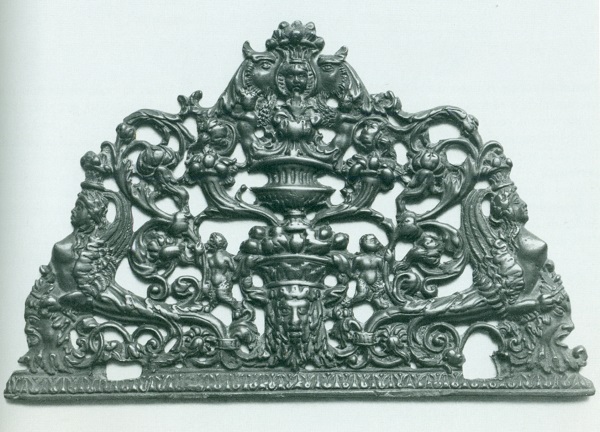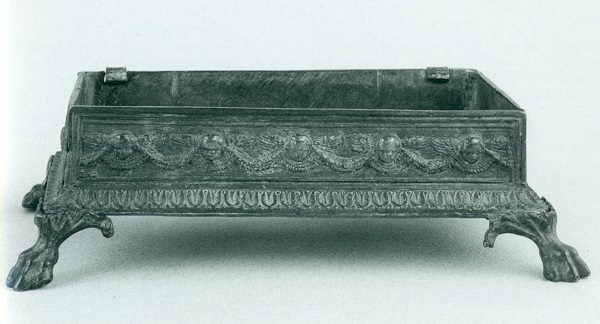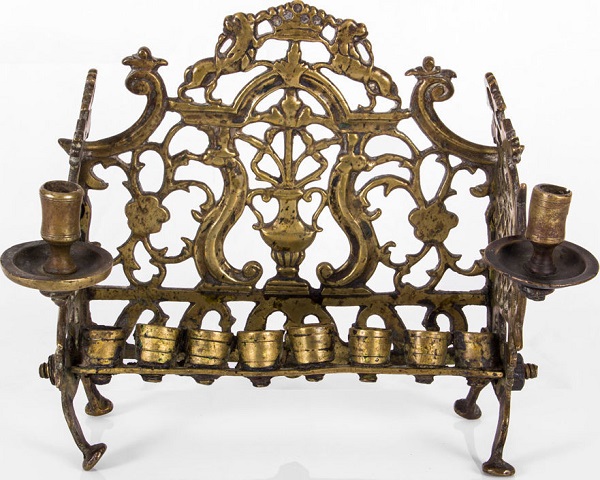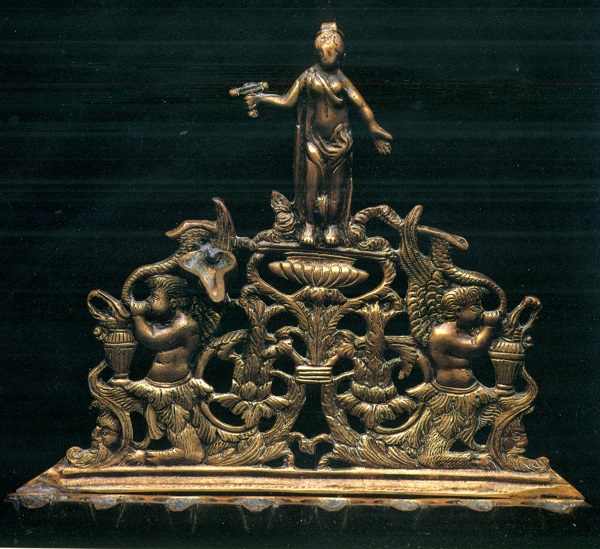Lampada di Chanukka
Chanukkà lamp (see english abstract below)
di Attilio Troncavini
Presso il museo Bardini di Firenze si conserva un bassorilievo traforato in bronzo [Figura 1] che Tommaso Rago, estensore del catalogo del 2009 curato da Antonella Nesi, definisce “fregio” e lo ritiene il probabile coperchio, forse raccordato da un elemento non pervenuto, di un cofanetto rettangolare simile a quello che si trova nello stesso museo [Figura 2].

Figure 1. Giuseppe de Levi (bottega), Placca per una lampada di Chanukkà, bronzo, cm. 13,5 x 21, Firenze, Museo Bardini inv. 1722 (Nesi-Rago, Museo Stefano Bardini. I bronzetti e gli oggetti d’uso in bronzo, Centro Di, Firenze 2009).

Figure 2. Severo da Ravenna (bottega), Cofanetto, bronzo, cm. 6,8 x 24,4, Firenze, Museo Bardini inv. 932.
Entrambi i manufatti vengono datati al 1530-50 e attribuiti alla bottega di Severo da Ravenna [Leggi].
Il cofanetto è plausibilmente da ritenere eseguito dalla bottega di Severo sulla base di confronti con opere rese note da Jeremy Warren e altri autori citate da Rago (nota 1).
Non è così per il “fregio” di cui alla Figura 1 che lo stesso Warren, nel 2014, svela essere la piastra di una chanukkià o lampada di Chanukkà (Hanukha) (nota 2).
Successivamente egli attribuisce l’oggetto a Giuseppe de Levi e alla sua bottega in una articolo pubblicato su The Burlington Magazine del novembre 2017 (CLIX pp. 880-885, nota 19) dove cita un precedente lavoro di Charles Avery (nota 3).
Proprio la bottega di Giuseppe de Levi, il cui cognome denuncia l’appartenenza al popolo ebraico, era specializzata nella produzione di questi oggetti che risultano comunque piuttosto rari in Italia.
Chanukkà è la festa delle luci, in memoria della riconsacrazione del Tempio dopo la vittoria dei Maccabei sui greci nel 164 a.e.v. [d.C.] e la riedificazione dell’altare profanato. Si celebra dalla sera del 24 del mese di kislev al 2 del mese di tevet (dicembre). Dura otto giorni, durante i quali si accendono progressivamente le otto luci della chanukkià (Chaim Grade, La moglie del rabbino, 1974, ed. it. Giuntina Firenze, p. 203).
Mostriamo un esemplare in bronzo di provenienza galiziana, databile alla fine del XVIII secolo [Figura 3].

Figura 3. Lampada di Chanukkà, bronzo, cm. 23 x 16, Galizia, fine XVIII secolo, asta Hammersite n. 164 lotto 20554.
Purtroppo la scarsa conoscenza degli oggetti rituali della tradizione ebraica induce in errore anche gli studiosi più seri. Eppure la letteratura, anche in lingua italiana, non manca. Possiamo citare, ed esempio, il catalogo di una mostra tenutasi a Ferrara tra il 1988 e il 1989 che pubblica diversi esemplari di lampada di Chanukkà, tra le quali una lampada in ottone confrontabile per epoca e fattura a quella del Museo Bardini [Figura 4].

Figura 4. Lampada di Chanukkà, ottone, cm. 22,5 x 12, XVI secolo, Modena, coll. priv. (AAVV, Arte e cultura ebraiche in Emilia-Romagna, catalogo della mostra, Ferrara 20.9.1988-15.1.1989, Mondadori, Milano 1988, p. 161 n. 91).
NOTE
[1] Ci si riferisce al Doppiere a forma di sirena dell’Asmolean Museum di Londra (Jeremy Warren in Donatello e il suo tempo, Milano 2001, p. 167), al David del Louvre, replica di quello del National Museum of Scotland (Warren 2001, op. cit. pp. 162-163), al cofanetto del Museo Correr di Londra (Katia Malatesta in Rinascimento e passione per l’antico. Andrea Riccio e il suo tempo, Trento 2008, pp. 388-389) e al cofanetto del Museo Civico Medioevale di Bologna (Tommaso Rago in Rinascimento … op. cit. pp. 390-391).
[2] Jeremy Warren, Medieval And Renaissance Sculpture in the Ashmolean Museum. Volume 3. Plaquettes, 2014, n. 404.
[3] Charles Avery, Joseph de Levis and Company: Renaissance Bronze-founders in Verona (Londra 2016).
Prima pubblicazione: Antiqua.mi, febbraio 2020
© Riproduzione riservata
English abstract
At the Bardini museum in Florence there is a openworked bronze bas-relief [Figure 1] which Tommaso Rago, extender of the 2009 catalog edited by Antonella Nesi, defines as “frieze” and considers it the probable lid, perhaps connected by an element not received, of a rectangular box similar to that found in the same museum [Figure 2]
Both are dated to 1530-50 and attributed to the workshop of Severo da Ravenna
The box is plausibly to be considered executed by the workshop of Severo on the basis of comparisons with works made known by Jeremy Warren and other authors cited by Rago [1].
This is not so for the “frieze” shown in Figure 1 that Warren himself, in 2014, reveals to be the plate of a chanukkià or Chanukkà (Hanukkha) lamp [2]. Subsequently he attributes the object to Giuseppe de Levi and his workshop in an article published in The Burlington Magazine of November 2017 (CLIX pp. 880-885, note 19) where he cites a previous work by Charles Avery [3].
Just the workshop of Giuseppe de Levi, whose surname denounces belonging to the Jewish people, was specialized in the production of these objects which are however quite rare in Italy.
Chanukka is the festival of lights, in memory of the rededication of the Temple after the victory of the Maccabees over the Greeks in 164 b.c.e. [a.D.] and the rebuilding of the desecrated altar. It is celebrated from the evening of the 24th of the month of kislev to the 2nd of the month of tevet (December). It lasts eight days, during which the eight lights of the chanukkià light up (Chaim Grade, Rabbi’s wife, 1974, ed. It. Giuntina Firenze, p. 203).
We show a bronze specimen of Galician origin, datable to the end of the XVIII century [Figure 3].
Unfortunately, the scarce knowledge of the ritual objects of the Jewish tradition misleads even the most serious scholars. Yet literature, even in Italian, is not lacking. We can cite, for example, the catalog of an exhibition held in Ferrara between 1988 and 1989 that publishes several specimens of Chanukkà lamp, including a brass lamp comparable by age and workmanship to that of the Bardini Museum [Figure 4].
[1] We refer to the siren-shaped doppiere of the Asmolean Museum in London (Warren in Donatello e il suo tempo, Milano 2001, p. 167), to the David of the Louvre, replica of that of the National Museum of Scotland (Warren, op. cit. pp. 162-163), to the casket of the Correr Museum in London (Katia Malatesta in Rinascimento e passione per l’antico. Andrea Riccio e il suo tempo, Trento 2008, pp. 388-389) and to the casket of the Civic Museum Medieval of Bologna (Tommaso Rago in Rinascimento … op. cit. pp. 390-391).
[2] Jeremy Warren, Medieval And Renaissance Sculpture in the Ashmolean Museum. Volume 3. Plaquettes, 2014, n. 404.
[3] Charles Avery, Joseph de Levis and Company: Renaissance Bronze-founders in Verona (London 2016).
